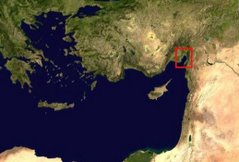
Further down the hill, we discovered the remains of another monumental building. In the picture below, you can discern two perpendicular walls, probably forming the corner of a room. Nearby villagers had directed us toward this area. They claimed that there used to be a Church in this area and that they had often stumbled upon mosaic fragments.

Although we found no mosaics, we stumbled upon three large chamber tombs cut into the natural bedrock. In the picture below you can see Pete crawling into one of these.

The next picture is a great shot of Rachel, crawling into the tomb head first.


From left to right: Dan, Pete, Rachel and Kathleen. Nothing like spending some quality time amongst friends in an ancient tomb...

...or perhaps a romantic evening... (Dan and Amanda)

Of course, creepy crawlies are a given in this kind of environment. Witness the horror/amusement at the sight of a VERY large and multicolored spider.
 Our investigations however, were not all fun and games. Most of these tombs had probably been looted and very few artifacts were found within them. In one of the tombs we came across a number of bones.
Our investigations however, were not all fun and games. Most of these tombs had probably been looted and very few artifacts were found within them. In one of the tombs we came across a number of bones. In the picture below, Rachel is holding a skull fragment in her right hand and a vertebrae fragment in her left.
In the picture below, Rachel is holding a skull fragment in her right hand and a vertebrae fragment in her left. Our dear Müge, the only one who could stand upright in one of our largest tombs:
Our dear Müge, the only one who could stand upright in one of our largest tombs: In addition to these finds, several other features were encountered, including a wine press, a possible ashlar quarry, two column shafts, and a column base. Most of the pottery collected from the site seems to date from the Hellenistic and Byzantine periods. This site may have consisted of a religious complex, including a Church, an administrative building, and agricultural dependencies. In my next post, I will share our discovery of an ancient canal system associated with the ancient site of Alexandretta, founded by Alexander the Great in the fourth century BCE.
In addition to these finds, several other features were encountered, including a wine press, a possible ashlar quarry, two column shafts, and a column base. Most of the pottery collected from the site seems to date from the Hellenistic and Byzantine periods. This site may have consisted of a religious complex, including a Church, an administrative building, and agricultural dependencies. In my next post, I will share our discovery of an ancient canal system associated with the ancient site of Alexandretta, founded by Alexander the Great in the fourth century BCE.
Cheers!
Amanda*


1 comment:
Im so jealous Amanda! I wish I could be there when you went into those tombs. Especially when you found bones! You know me with bones :) Its good to see you having some fun amidst the back breaking work!
Who and where do the bones go to then from where you find them? Or are they just kept in the tombs?
How are they then categorized and stored?
Are they usually full skeletal structures that you find? Or does that usually get disturbed with the looting?
Cant wait to see more!
RJ*
Post a Comment